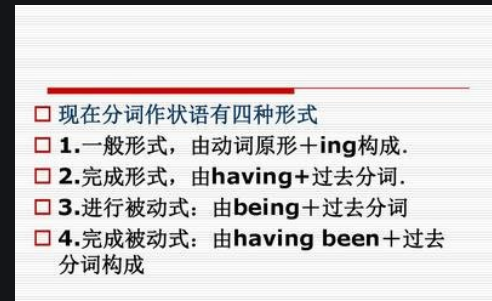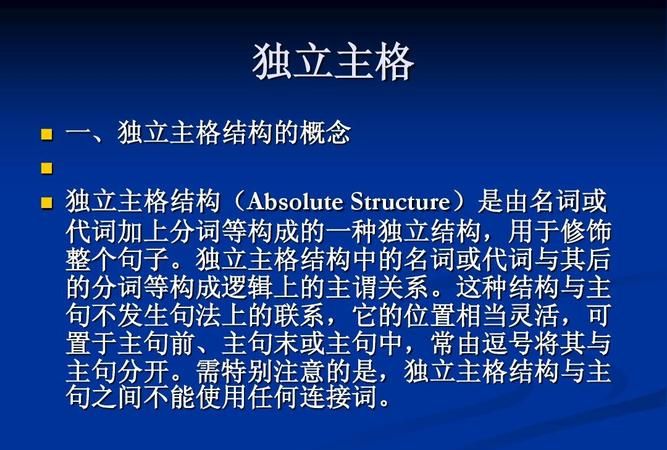本文目录
独立主格8种基本句型例句和非谓语
独立主格8种基本句型例句是:
1、名词/代词+现在分词。
2、名词/代词+过去分词。
3、名词/代词+不定式。
4、名词/代词+名词。
5.名词/代词+形容词短语。
6.名词/代词+副词。
7.名词/代词+介词短语。
8.with引导的复合结构,也可以认为是一种独立主格结构。

独立主格简介:
我们称动作状态实行者为逻辑主语,称该状态为逻辑谓语,在中文翻译上与状语从句没什么区别。
“独立主格结构”是由名词或代词作为逻辑主语,加上分词、形容词、副词、动词不定式或介词短语作为逻辑谓语构成。这种结构在形式上与主句没有关系,通常称为“独立主格结构”。
独立主格8种基本句型例句和非谓语
独立主格8种基本句型例句有如下:
1、“名词/代词+不定式”结构
由不定式构成的独立主格 结构往往表示还未发生的动作或状态,在句中常作原因状语,偶尔作条件状语。例如:
His friends to come tonight,he is busy preparing the dinner.
他的朋友今晚要来,他正忙着准备晚餐。
No one to wake me up,I might be late for the first class.
如果没人叫醒我,我会错过第一节课的。
2、“名词/代词+现在分词”结构
现在分词表示前面的名词或代词主动进行的动作或状态等。“独立结构”中的being或 having been有时可以省去,这样就成了无动词分句或过去分词分句。例如:
The man lay there, his hands trembling.
那个男子躺在那儿,双手在颤抖。
So many students being absent, the meeting had to be put off.
那么多学生没到,会议不得不推迟。
His homework having been done, Tom went to sleep.
做完作业后,汤姆睡着了。
3、“名词/代词+过去分词”结构
过去分词表示前面的名词或代词被动完成的动作或所处的一种状态。例如:
he boy lay on his back, his hands crossed under his head.
男孩仰卧着,双手交叉放在头下。
4、“名词/代词+名词”结构
名词一般做前面名词或代词的同位语。例如:
Many people joined in the work, some of them women and children.
许多人参加了这项工作,其中有些是妇女和儿童。
He fought the tiger,a stick his only weapon.
他与老虎搏斗,那是他唯一的武器。

5、“名词/代词+形容词”结构
形容词(短语)说明前面名词或代词的性质,状态,原因等。例如:
The floor wet and slippery, we had to stay outside for a while.
地面很湿,我们只好在外面呆一会儿。
I heard that she got injured in the accident, my heart full of sorry.
我听说她在这场事故中受伤了,心中充满担忧。(形容词,表伴随)。
这两个句子也可以看成是省略了being,如果加上,就变成了现在分词分句。
6、“逻辑主语+副词”结构
副词说明前面名词或代词的状态。例如:
The meeting over, we all went home.
会议结束,我们都回家了。
7、“逻辑主语+介词短语”结构
介词短语说明伴随前面名词或代词的方式或者状态。例如:
The teacher came in, a book under his arm.
老师在他的胳膊下夹着一本书进来了。
The hunter entered the forest, gun in hand.
那位猎人手里提着枪走进了树林。
Nobody at home, the thief took a lot of things away.
家里很多东西都没人拿走。
8、“with/without”引导的独立主格结构
A woman got on the bus with a baby around her arms.
一位妇女抱着一个婴儿上了公共汽车。
独立主格结构的八种形式
一、独立主格结构基本构成形式 名词(代词)+现在分词(过去分词;形容词;副词;不定式;名词;介词短语) 1. 名词(代词)+现在分词Night enshrouding the earth, nobody could make out what the dark mass was from a distance.黑夜笼罩大地,谁也看不清远处黑压压的一片是什么东西。There being no bus, we had to walk home. 由于没有公共汽车,我们只好走回家。 2. 名词(代词)+过去分词The workers worked still harder, their living conditions greatly improved. 由于工人们的生活条件大大提高,他们工作得更起劲了。He was listening attentively in class, his eyes fixed on the blackboard. 他上课专心听讲,眼睛紧盯着黑板。 3. 名词(代词)+不定式在“名词/代词+动词不定式”结构中,动词不定式和它前面的名词或代词如果存在着逻辑上的主谓关系,动词不定式则用主动的形式;如果是动宾关系,则用被动形式。The four of us agreed on a division of labor, each to translate a quarter of the book. 我们四人同意分工干,每人翻译全书的四分之一。Many trees, flowers, and grass to be planted, our newly-built school will look even more beautiful. 种上许多的树、花和草后,我们新建的学校看上去将更美。 4. 名词(代词)+形容词The Trojans asleep, the Greek soldiers crept out of the hollow wooden horse.特洛伊人睡着了,于是希腊士兵从中空的木马里悄悄爬了出来。Computers very small, we can use them widely. 电脑虽小,我们却能广泛地利用它们。 5. 名词(代词)+副词The meeting over, our headmaster soon left the meeting room. 散会了,校长很快就离开了会议室。The lights off, we could not go on with the work. 灯熄了,我们不能继续工作了。 6. 名词(代词)+名词His first shot failure,he fired again.他第一枪没击中,又打了一枪。Two hundred people died in the accident, many of them children. 两百人死于事故,其中有许多儿童。 7. 名词(代词) +介词短语He lay at full length upon his stomach,his head resting upon his left forearm.他的脊背朝天,四肢伸展,头枕着左臂,直挺挺地趴伏着。Every afternoon a very old woman hobbled past the old house,a vast load of firewood on her back.每天下午,一个背着一大背柴禾的老妇人都会从那间破旧的房屋前蹒跚着走过。 二、with,without 引导的独立主格结构 with ( without)+宾语(名词/代词)+宾语补足语,宾语通常由名词或代词充当,但代词一定要用宾格。上文的独立主格结构的几种情况都适用于此结构。 The girl hid her box without anyone knowing where it was. 小女孩把盒子藏了起来,没有人知道它在哪里。(without +名词/代词+动词的-ing形式) Without a word more spoken, she left the meeting room. 她没再说什么话就离开了会议室。(without+名词/代词+动词的-ed形式) The kid feels excited with so many places of interest to visit. 有这么多的名胜可参观,小孩很激动。(with+名词/代词+动词不定式) The boy was walking, with his father ahead. 父亲在前,小孩在后走着。(with+名词/代词+副词) He stood at the door, with a computer in his hand. 或He stood at the door, computer in hand. 他站在门口,手里拿着一部电脑。(with+名词/代词+介词短语) With his son so disappointing, the old man felt unhappy. 由于儿子如此令人失望,老人感到很不快乐。(with+名词/代词+形容词)在with (without) 的复合结构中,多数情况下with 能省略,但without 不能省略。

独立主格结构的八种基本句型
非谓语动词作状语,其逻辑主语须与主句主语保持一致。若不一致,非谓语动词形式须另带主语,从而构成复合结构的形式作状语。这种结构称为“独立结构”。其中,非谓语动词主动用现在分词,被动用过去分词。 非谓语动词及其短语前面带有逻辑主语,逻辑主语的代词又是主格,故常称为“独立主格”。“独立结构”在句中起状语作用,相当于状语从句,表示时间、原因、条件、方式或伴随等情况。
编辑本段功能
独立主格结构主要用于描绘性文字中,其作用相当于一个状语从句,常用来表示时间、原因、条件、行为方式或伴随情况等。例如:
表示时间
The meeting being over, all of us went home. 开完会后我们都回家了。 Her work done, she sat down for a cup of tea. 她干完了活,坐下来喝茶。
表示条件
The condition being favourable, he may succeed. 若条件有利,他或许能成功。
表示原因
There being no taxis, we had to walk. 没有出租车,我们只好步行。 He wrapped her up with great care, the night being dark and frosty. 夜又黑又冷,所以他把她裹得严严实实的。
表示伴随情况
Almost all metals are good conductors, silver being the best of all. 几乎所有的金属都是良导体,而银则是最好的导体。(=Almost all metals are good conductors, and silver is the best of all.)
编辑本段用法
独立主格结构主要表示谓语动词发生的时间、原因、条件或伴随情况等,相当于一个状语从句或并列句。
用作时间状语
The work done(=After the work had been done), we went home. 工作完成后,我们就回家了。
用作条件状语
Weather permitting(=If weather permits), they will go on an outing to the beach tomorrow. 如果天气允许的话,他们将在明天组织一次海滨小游。
用作原因状语
An important lecture to be given tomorrow(=As an important lecture will be given tomorrow), the professor has to stay up late into the night. 因为明天要发表一个重要的演讲,教授不得不熬夜到很晚。
用作伴随状语
He was lying on the grass,his hands crossed under his head(=and his hands were crossed under his head).他躺在草地上,两手交叉枕在脑后。
表示补充说明
We redoubled our efforts, each man working like two. 我们加倍努力,一个人干两个人的活。 *注:独立主格结构表示时间、条件或原因时,相当于一个状语从句,一般放在句首,表示原因时还可放在句末;表伴随状况或补充说明时,相当于一个并列句,通常放于句末。
编辑本段形式
1>一般独立主格形式:与主句逻辑关系松散
形式为: n. + -ed/-ing形式; n. + 不定式 ; n. + 介词短语; n. + 形容词; n. + 副词. ;
名词/主格代词+现在分词
名词/主格代词与现在分词之间是主谓关系。如: The girl staring at him(= As the girl stared at him), he didn't know what to say. 姑娘两眼望着他,他不知道说什么好。 Time permitting(= If time permits), we will go for an outing tomorrow. 如果时间允许的话,我们明天去郊游。
名词/主格代词+过去分词
名词/主格代词与过去分词之间是动宾关系。如: The problems solved(= As the problems were solved), the quality has been improved. 随着问题的解决,质量已经提高了。 Her glasses broken(= Because her glasses were broken), she couldn't see the words on the blackboard. 由于眼镜摔坏了,她看不见黑板上的字。
名词/主格代词+不定式
名词/主格代词与不定式之间是主谓关系,且强调的是一次具体性的动作。如: He is going to make a model plane, some old parts to help. 借助于一些旧零件,他要做一个飞机模型。 They said good-bye to each other, one to go home, the other to go to the bookstore. 他们道别后,一个回了家,一个去了书店。
名词/主格代词+形容词
如: An air accident happened to the plane,nobody alive. 那架飞机遭遇了空难,无一人生还。 So many people absent, the meeting had to be called off. 这么多人缺席,会议不得不取消。
名词/主格代词+副词
如: He put on his sweater ,wrong side out. 他把毛衣穿反了。 The meeting over, they all went home. 会议一结束,他们就都回家了。
名词/主格代词+介词短语
如: The boy goes to the classroom,book in hand. 那男孩手里拿着书去教室。 Mary was sitting near the fire, her back towards the door. 玛丽靠近火炉坐着,背对着门。 2>with 引导的独立主格:与主句逻辑关系紧密 形式为: with + n. + -ed/-ing形式; with + n. +abj.; with +n. + 介词短语 3>each引导的强调型独立主格:强调句尾的复数名词 形式为:句子 + 复数名词结尾 , each + 介词短语/形容词短语/名词短语/-ing形式/-ed形式 如: Under the restructuring, the huge organization that operates the company's basic businesses will be divided into five groups, each with its own executive.(题源:《GMAT语法全解》白勇著,Page38) 4>其他形式
There being +名词(代词)
如: There being nothing else to do, we went home. 没有别的事可做,我们就回家了。 There being no further business, I declare the meeting closed. 没有再要讨论的事了,我宣布散会。
It being +名词(代词)
如: It being Christmas, the government offices were closed. 由于圣诞节的缘故,政府机关都休息。 It being a holiday, all the shops were shut. 由于今天是假日,所有商店都关门了。
编辑本段特点
1)独立主格结构的逻辑主语与句子的主语不同,它独立存在。 2)名词或代词与后面的分词,形容词,副词,不定 式,介词等是主谓关系。 3)独立主格结构一般有逗号与主句分开。 举例: The test finished, we began our holiday. = When the test was finished, we began our holiday. 考试结束了,我们开始放假。 The president assassinated, the whole country was in deep sorrow. = After the president was assassinated, the whole country was in deep sorrow. 总统被谋杀了,举国上下沉浸在悲哀之中。 Weather permitting, we are going to visit you tomorrow. 如果天气允许,我们明天去看你。 This done, we went home. 工作完成后,我们才回家。 The meeting gone over, everyone tired to go home earlier. 会议结束后,每个人都想早点回家。 He came into the room,his ears red with cold. 他回到了房子里,耳朵冻坏了。 He came out of the library, a large book under his arm. 他夹着本厚书,走出了图书馆 注:独立主格结构有时可在其前加上介词with。 如:Don’t sleep with the windows open.别开着窗睡觉。 He was lying on the bed with all his clothes on. 他和衣躺在床上。 She came in with a book in her hand. 她手里拿着一本书走了进来。 He fell asleep with the lamp burning. 他没熄灯就睡着了。 I won’t be able to go on holiday with my mother being ill. 因为妈妈有病,我无法去度假。 He sat there with his eyes closed. 他闭目坐在那儿。 All the afternoon he worked with the door locked.整个下午他都锁着门在房里工作。 I can’t go out with all these clothes to wash. 要洗这些衣服,我无法出去了。
特殊
当独立主格与主句主语不同时可有:eg:We walking through the garden,the flowers are beautiful.
编辑本段注意事项
1.独立主格与状语从句的转换当状语从句的主语与主句的主语不是指同一个对象时,可用独立主格结构取代状语从句,但不再保留连词。如:After class was over (=Class being over / Class over), the students soon left the classroom.下课后,学生很快离开了课室。 2. 不能省略being (having been)的情形:在下列两种情况下,独立主格结构中的being(或having been)不能省略。 (1) 独立主格的逻辑主语是代词时。如:It being Sunday, we went to church.因为是星期天,我们去了做礼拜。 (2)在There being+名词的结构中。如:There being no bus, we had to go home on foot.因为没有公共汽车,所以我们不得不步行回家。 3. 在“名词(或代词)+介词短语”构成的独立主格结构中,一般不用形容词性物主代词和冠词。如: Miss Smith entered the classroom, book in hand.史密斯小姐走进了课室,手里拿着一本书。比较with的复合结构。如:Miss Smith entered the classroom, with a book in her hand. 4. 独立主格结构没有所有格形式The chief-editor arriving, we began the meeting. 主编来了,我们开始开会。(比较动名词复合结构。)
编辑本段示例
请看下面一道题: Not far from the school there was a garden, _________ owner seated in it playing chess with his little grandson every afternoon. A. its B. whose C. which D. that 【分析】此题很容易误选B,许多同学会认为句中逗号后是一个非限制性的定语从句,whose 在定语从句中用作定语修饰其后的名词 owner。此分析从表面上看,似乎天衣无缝,但实质上是错的,原因是空格后根本不是一个句子,因为没有谓语。尽管句中有两个动词,但它们都是非谓语动词。也许有的同学认为,其中的 seated 可视为谓语动词,但是注意,seat 用作动词时,它总是及物的,其后要么接宾语,要么它就用于被动语态,所以若在 seated 前加上助动词 is,则可以选择B(当然若将 seated 改为sitting,也应选择A)。所以此题最佳答案选A。 请再看一个类似的例子: (1) He wrote a lot of novels, many of _________ translated into foreign languages. A. it B. them C.which D. that (2) He wrote a lot of novels, many of _________ were translated into foreign languages.A. it B. them C. which D. that 第(1)应选B,而不能选C,是因为句中的 translated 是过去分词(非谓语动词),若选C,则该从句无谓语;第(2)应选C,该句是典型的非限制性定语从句,因为该句修饰的是前面的novels,即指物,所以只能用which做of的宾语,故本题选C。 再请看下面一例: (3) He wrote a lot of novels, and many of _________ were translated into foreign languages. A. it B. them C. which D. that 【分析】此题与上面的第(2)题不同,两句间多了一个并列连词and,说明这是一个并列句,故应选B,则不能选C。 请做做以下三题(答案均为B): (1) There I met several people, two of _________ being foreigners.(独立主格结构) A. which B. them C. whom D. that (2) There I met several people, two of _________ were foreigners. (非限制性定语从句) A. which B. whom C. who D. that (3) There I met several people, and two of _________ were foreigners.(两个句子) A. which B. them C. whom D. that

以上就是关于引导独立主格结构的介词 ,独立主格8种基本句型例句和非谓语的全部内容,以及引导独立主格结构的介词 的相关内容,希望能够帮到您。

